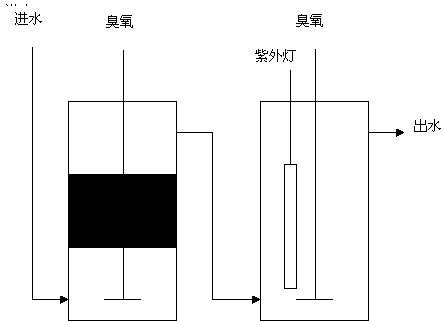Method for removing effluent chromaticity of excrement waste water by biochemical treatment
A fecal wastewater and biochemical treatment technology, applied in water/sewage treatment, toilet black water treatment, chemical instruments and methods, etc., can solve the problems of difficult decolorization and high chroma of effluent, and achieve the effect of easy decomposition and strong ozone oxidation
- Summary
- Abstract
- Description
- Claims
- Application Information
AI Technical Summary
Problems solved by technology
Method used
Image
Examples
Embodiment 1
[0040] (1) Water intake requirements for decolorization: Firstly, the biochemical treatment of fecal wastewater, except for chroma, meets the water quality requirements for toilet flushing in "Urban Sewage Recycling and Utilization of Urban Miscellaneous Water Quality" (GB / T18920-2002), and the chroma is 50 degrees to 150 degrees Spend.
[0041] (2) First-level decolorization treatment: 100L of wastewater that meets the requirements of step (1) enters the first-level decolorization, and 50L of coconut shell activated carbon is added as a catalyst. It is 180mg / L of ozone.
[0042] (3) Secondary decolorization treatment: the wastewater treated in step (2) enters the secondary decolorization, put in a UV lamp with a power of 60W and a wavelength of 280nm to 190nm to emit ultraviolet light as a catalyst, and use micropore aeration Introduce ozone with a flow rate of 5 L / min and a concentration of 100 mg / L into the wastewater for 10 minutes.
[0043] (4) The effluent from step (3...
Embodiment 2
[0045] (1) Water intake requirements for decolorization: Firstly, the biochemical treatment of fecal wastewater, except for chroma, meets the water quality requirements for toilet flushing in "Urban Sewage Recycling and Utilization of Urban Miscellaneous Water Quality" (GB / T18920-2002), and the chroma is 50 degrees to 150 degrees Spend.
[0046](2) First-level decolorization treatment: 100L of wastewater that meets the requirements of step (1) enters into the first-level decolorization, and 45L of coconut shell activated carbon is added as a catalyst. It is 150mg / L of ozone.
[0047] (3) Secondary decolorization treatment: The wastewater treated in step (2) enters the secondary decolorization, put in a UV lamp with a power of 40W and a wavelength of 280nm~190nm to emit ultraviolet light as a catalyst, and use micropore aeration Introduce ozone with a flow rate of 15 L / min and a concentration of 70 mg / L into the wastewater for 30 minutes.
[0048] (4) The effluent from step (...
Embodiment 3
[0050] (1) Water intake requirements for decolorization: Firstly, the biochemical treatment of fecal wastewater, except for chroma, meets the water quality requirements for toilet flushing in "Urban Sewage Recycling and Utilization of Urban Miscellaneous Water Quality" (GB / T18920-2002), and the chroma is 50 degrees to 150 degrees Spend.
[0051] (2) Primary decolorization treatment: Put 100L of waste water that meets the requirements of step (1) into primary decolorization, add 35L of coconut shell activated carbon as a catalyst, and pass microporous aeration into the waste water for 50 minutes with a flow rate of 40L / min and a concentration of It is 125mg / L of ozone.
[0052] (3) Secondary decolorization treatment: The wastewater treated in step (2) enters the secondary decolorization, put in a UV lamp with a power of 30W and a wavelength of 280nm~190nm to emit ultraviolet light as a catalyst, and use micropore aeration Introduce ozone with a flow rate of 25 L / min and a conc...
PUM
 Login to View More
Login to View More Abstract
Description
Claims
Application Information
 Login to View More
Login to View More - R&D
- Intellectual Property
- Life Sciences
- Materials
- Tech Scout
- Unparalleled Data Quality
- Higher Quality Content
- 60% Fewer Hallucinations
Browse by: Latest US Patents, China's latest patents, Technical Efficacy Thesaurus, Application Domain, Technology Topic, Popular Technical Reports.
© 2025 PatSnap. All rights reserved.Legal|Privacy policy|Modern Slavery Act Transparency Statement|Sitemap|About US| Contact US: help@patsnap.com

